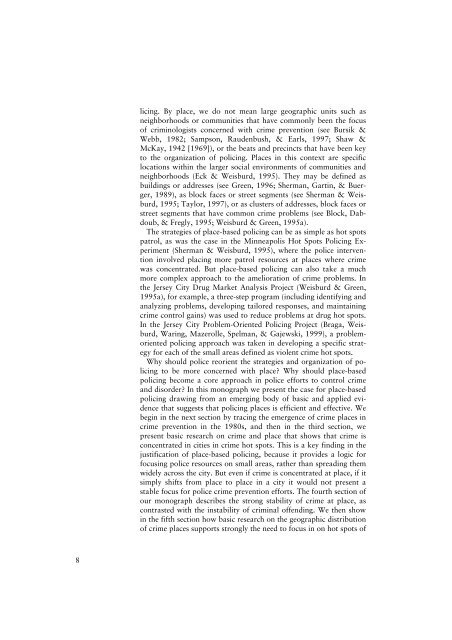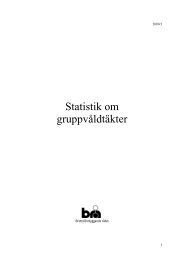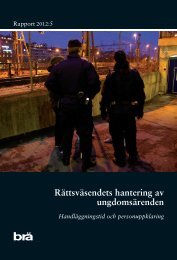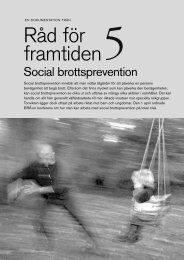The Importance of Place in Policing - Empirical Evidence and Policy ...
The Importance of Place in Policing - Empirical Evidence and Policy ...
The Importance of Place in Policing - Empirical Evidence and Policy ...
You also want an ePaper? Increase the reach of your titles
YUMPU automatically turns print PDFs into web optimized ePapers that Google loves.
8lic<strong>in</strong>g. By place, we do not mean large geographic units such asneighborhoods or communities that have commonly been the focus<strong>of</strong> crim<strong>in</strong>ologists concerned with crime prevention (see Bursik &Webb, 1982; Sampson, Raudenbush, & Earls, 1997; Shaw &McKay, 1942 [1969]), or the beats <strong>and</strong> prec<strong>in</strong>cts that have been keyto the organization <strong>of</strong> polic<strong>in</strong>g. <strong>Place</strong>s <strong>in</strong> this context are specificlocations with<strong>in</strong> the larger social environments <strong>of</strong> communities <strong>and</strong>neighborhoods (Eck & Weisburd, 1995). <strong>The</strong>y may be def<strong>in</strong>ed asbuild<strong>in</strong>gs or addresses (see Green, 1996; Sherman, Gart<strong>in</strong>, & Buerger,1989), as block faces or street segments (see Sherman & Weisburd,1995; Taylor, 1997), or as clusters <strong>of</strong> addresses, block faces orstreet segments that have common crime problems (see Block, Dabdoub,& Fregly, 1995; Weisburd & Green, 1995a).<strong>The</strong> strategies <strong>of</strong> place-based polic<strong>in</strong>g can be as simple as hot spotspatrol, as was the case <strong>in</strong> the M<strong>in</strong>neapolis Hot Spots Polic<strong>in</strong>g Experiment(Sherman & Weisburd, 1995), where the police <strong>in</strong>tervention<strong>in</strong>volved plac<strong>in</strong>g more patrol resources at places where crimewas concentrated. But place-based polic<strong>in</strong>g can also take a muchmore complex approach to the amelioration <strong>of</strong> crime problems. Inthe Jersey City Drug Market Analysis Project (Weisburd & Green,1995a), for example, a three-step program (<strong>in</strong>clud<strong>in</strong>g identify<strong>in</strong>g <strong>and</strong>analyz<strong>in</strong>g problems, develop<strong>in</strong>g tailored responses, <strong>and</strong> ma<strong>in</strong>ta<strong>in</strong><strong>in</strong>gcrime control ga<strong>in</strong>s) was used to reduce problems at drug hot spots.In the Jersey City Problem-Oriented Polic<strong>in</strong>g Project (Braga, Weisburd,War<strong>in</strong>g, Mazerolle, Spelman, & Gajewski, 1999), a problemorientedpolic<strong>in</strong>g approach was taken <strong>in</strong> develop<strong>in</strong>g a specific strategyfor each <strong>of</strong> the small areas def<strong>in</strong>ed as violent crime hot spots.Why should police reorient the strategies <strong>and</strong> organization <strong>of</strong> polic<strong>in</strong>gto be more concerned with place? Why should place-basedpolic<strong>in</strong>g become a core approach <strong>in</strong> police efforts to control crime<strong>and</strong> disorder? In this monograph we present the case for place-basedpolic<strong>in</strong>g draw<strong>in</strong>g from an emerg<strong>in</strong>g body <strong>of</strong> basic <strong>and</strong> applied evidencethat suggests that polic<strong>in</strong>g places is efficient <strong>and</strong> effective. Webeg<strong>in</strong> <strong>in</strong> the next section by trac<strong>in</strong>g the emergence <strong>of</strong> crime places <strong>in</strong>crime prevention <strong>in</strong> the 1980s, <strong>and</strong> then <strong>in</strong> the third section, wepresent basic research on crime <strong>and</strong> place that shows that crime isconcentrated <strong>in</strong> cities <strong>in</strong> crime hot spots. This is a key f<strong>in</strong>d<strong>in</strong>g <strong>in</strong> thejustification <strong>of</strong> place-based polic<strong>in</strong>g, because it provides a logic forfocus<strong>in</strong>g police resources on small areas, rather than spread<strong>in</strong>g themwidely across the city. But even if crime is concentrated at place, if itsimply shifts from place to place <strong>in</strong> a city it would not present astable focus for police crime prevention efforts. <strong>The</strong> fourth section <strong>of</strong>our monograph describes the strong stability <strong>of</strong> crime at place, ascontrasted with the <strong>in</strong>stability <strong>of</strong> crim<strong>in</strong>al <strong>of</strong>fend<strong>in</strong>g. We then show<strong>in</strong> the fifth section how basic research on the geographic distribution<strong>of</strong> crime places supports strongly the need to focus <strong>in</strong> on hot spots <strong>of</strong>
















